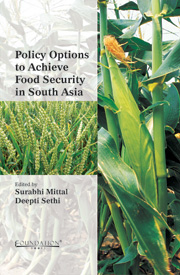Book contents
- Frontmatter
- Contents
- List of Contributors
- Foreword
- Acknowledgements
- List of Abbreviations
- 1 Food Security in South Asia
- 2 Food Security in India: Policies and Options
- 3 Multiple Facets of Food (In) Security in Sri Lanka: An Input to Food Policy
- 4 Food Security in Bangladesh: Achievements, Challenges and Way Forward
- 5 State of Agriculture and Food Security in Pakistan
- 6 Food Security Situation in Nepal: Issues and Suggested Policy Measures
- 7 Food Security in Maldives
- 8 Role of Regional Trade and Rural Development for Food Security in Bhutan
- 9 Food Security in Afghanistan
8 - Role of Regional Trade and Rural Development for Food Security in Bhutan
Published online by Cambridge University Press: 05 June 2012
- Frontmatter
- Contents
- List of Contributors
- Foreword
- Acknowledgements
- List of Abbreviations
- 1 Food Security in South Asia
- 2 Food Security in India: Policies and Options
- 3 Multiple Facets of Food (In) Security in Sri Lanka: An Input to Food Policy
- 4 Food Security in Bangladesh: Achievements, Challenges and Way Forward
- 5 State of Agriculture and Food Security in Pakistan
- 6 Food Security Situation in Nepal: Issues and Suggested Policy Measures
- 7 Food Security in Maldives
- 8 Role of Regional Trade and Rural Development for Food Security in Bhutan
- 9 Food Security in Afghanistan
Summary
Introduction
Bhutan is a small land-locked country with a population of 553,000 covering an area of 38,394 (Bhutan Statistical Yearbook, 2006) square kilometres. Ever since Bhutan came out of its self-imposed isolation in the 1960s, it has achieved remarkable socio-economic development. The country's real annual economic growth averaged about 7–8 per cent over the last two decades and grew by 8.5 per cent in 2006 (HDR, 2005). Bhutan's economic base remains narrow, and the economy is heavily dependent on the hydropower sector which accounts for some 12 per cent of the country's GDP and 45 per cent of national revenues. Bhutan's per capita Gross Domestic Product has increased from US$ 51 in 1961 (the lowest in the world at that time) to US$ 239 in 1980, and US$ 1,523 in 2007 (one of the highest in South Asia). The economic growth in Bhutan has been driven by the construction of hydropower projects and the official development assistance from donors.
Despite high economic growth, about 32 per cent of the population in Bhutan remains below national poverty line and majority of them live in rural areas according to the Poverty Assessment Report of 2004. The same report shows high level of income inequalities with a gini-coefficient 0.42.
With free and compulsory education system in the country, large number of youths entered the labour market but the hydropower and its related industries, have low employment elasticity.
- Type
- Chapter
- Information
- Policy Options to Achieve Food Security in South Asia , pp. 182 - 205Publisher: Foundation BooksPrint publication year: 2011

